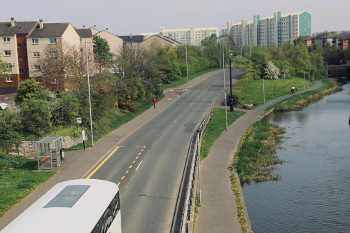Analysis by Sustrans Scotland has revealed that the rate of traffic incidents involving children on foot or bike in the most deprived areas of Scotland is three times that in the least deprived areas.
While it is well established that there are more road traffic accidents in more deprived areas, Sustrans' new data looks at children travelling on foot or by bike only, and maps clusters of incidents.
It also made a direct comparison between the 20% most deprived and 20% least deprived areas in Scotland.
The walking and cycling charity’s findings were be presented at the Scottish Transport Applications Research conference as part of a presentation entitled 'Investing in cycling to tackle transport poverty and promote equity'.

Council housing in Edinburgh
Sustrans Scotland national director John Lauder said: ‘This analysis shines a light on a “double injustice” being done to Scotland’s poorest communities.
'Firstly – communities are locked out of opportunities through transport poverty. Secondly, children in those communities are at three times higher risk of death or injury while out walking or cycling – simply due to their postcode.
‘We are calling on local authorities and government to implement more widespread high-quality infrastructure and slower speed streets to make children and young people safer, especially in Scotland’s most disadvantaged areas.’
Sustrans Scotland compared road casualty data for slight and serious injuries with the Scottish Index of Multiple Deprivation to work out the risk to children in different areas. This produced the average risk of being involved in an incident across Scotland, depending on level of deprivation.
It said the risk for a child on foot or bike of being involved in a road traffic incident increases as areas become more deprived. From an average of 0.25 incidents per data zone in the least deprived areas to an average of 0.83 incidents per data zone in the most deprived areas.
However, the charity admitted that one reason for the disparity could be that ‘deprived areas are often denser and busier, so you might expect more casualties as there are more people around’ and that ‘car ownership is likely to be low in these areas … which means that more people are out on foot or a bike on the way to school or work’.
In terms of solutions. it suggested appropriate crossings, wide pavements, and comfortable walking routes for pedestrians and segregated space for cyclists, as well as lower speed limits.
It added that there is a need for more research to better understand the causes of this inequality.
Register now for full access
Register just once to get unrestricted, real-time coverage of the issues and challenges facing UK transport and highways engineers.
Full website content includes the latest news, exclusive commentary from leading industry figures and detailed topical analysis of the highways, transportation, environment and place-shaping sectors.
Use the link below to register your details for full, free access.
Already a registered? Login